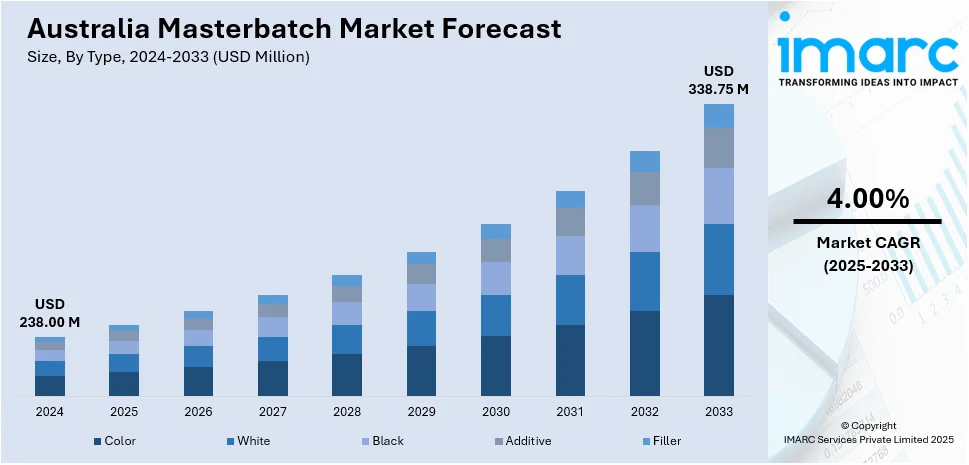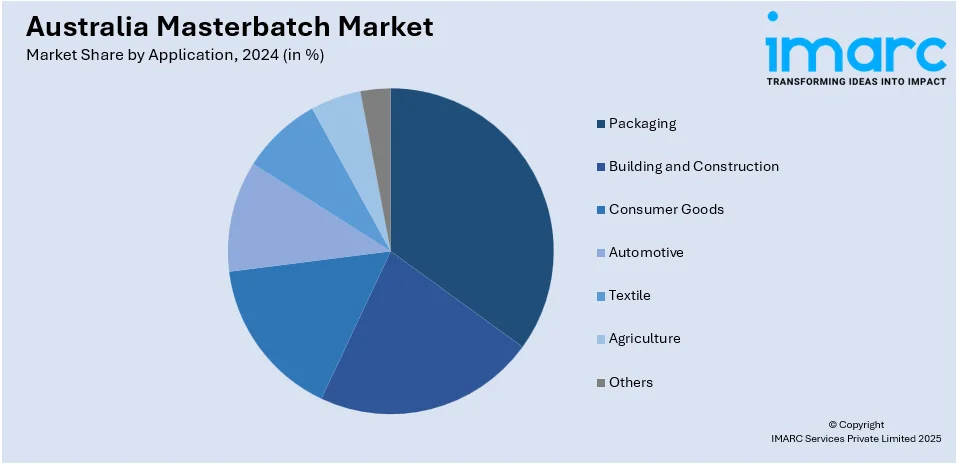
Australia Masterbatch Market Size, Share, Trends and Forecast by Type, Polymer Type, Application, and Region, 2025-2033
Australia Masterbatch Market Overview:
The Australia masterbatch market size reached USD 238.00 Million in 2024. Looking forward, IMARC Group expects the market to reach USD 338.75 Million by 2033, exhibiting a growth rate (CAGR) of 4.00% during 2025-2033. The robust product demand from the expanding packaging sector, automotive lightweighting initiatives, infrastructure growth in the construction and agriculture sectors, and the surging need for functional and ultraviolet (UV)/flame-resistant formulations are some of the key factors propelling the market growth.
|
Report Attribute
|
Key Statistics
|
|---|---|
|
Base Year
|
2024
|
|
Forecast Years
|
2025-2033
|
|
Historical Years
|
2019-2024
|
| Market Size in 2024 | USD 238.00 Million |
| Market Forecast in 2033 | USD 338.75 Million |
| Market Growth Rate 2025-2033 | 4.00% |
Australia Masterbatch Market Trends:
Surge in Packaging and Automotive Demand Driving Masterbatch Consumption
Australia’s masterbatch market is experiencing strong growth driven by surging demand in plastic packaging and automotive lightweighting. The packaging sector is fueled by rising e-commerce penetration and food-service packaging needs, with 17.08 million Australians shopping online monthly in 2024, marking a 45% increase from 2020. This growth has spurred plastic packaging exports, where color, barrier, and functional masterbatches are essential for flexible films, rigid containers, and labels. Meanwhile, automotive manufacturers are intensifying efforts to reduce vehicle weight for better fuel efficiency and emissions compliance, increasing the demand for additive and color masterbatches in under-hood, interior, and exterior components. The Australian automotive composites market, valued at USD 570 million in 2024, is set to expand at a 7% CAGR through 2033, reaching over USD 1.1 billion. With local SUV and light truck production reaching 19.27k vehicles in 2029, tier-1 suppliers are boosting masterbatch output to meet the demand for consistent interior trim and bumper colors. This growth in packaging and automotive sectors is driving investment in expanded extrusion lines and onshore color labs across Australia, thus aiding in market expansion.

To get more information on this market, Request Sample
Sustainability Mandates and the Rise of Eco-friendly Masterbatches
Environmental regulations and corporate net-zero commitments are driving the adoption of bio-based, biodegradable, and post-consumer recycled (PCR) masterbatches in Australia. Under the 2025 National Plastics Plan, Australia aims to recover or recycle 70% of plastic packaging by 2025, though recovery rates were just 18% as of mid-2023, creating pressure on converters to integrate recycled content and recyclable additives. Consequently, demand for sustainable masterbatches, used to improve mechanical properties and color uniformity in PCR resin blends, has surged. This trend aligns with the broader sustainable packaging sector, which was valued at USD 12.7 billion in 2024 and is projected to grow at a 7.2% CAGR, reaching USD 23.7 billion by 2033. Polymers like recycled HDPE and PCR PET require compatibilizer masterbatches to match virgin-equivalent performance, prompting suppliers to introduce certified green product lines. Furthermore, tax incentives provide offsets for capital equipment utilized in recycled-content compounding, driving new investments in post-consumer recycled (PCR) masterbatch extrusion projects nationwide.
Australia Masterbatch Market Segmentation:
IMARC Group provides an analysis of the key trends in each segment of the market, along with forecasts at the region/country level for 2025-2033. Our report has categorized the market based on type, polymer type, and application.
Type Insights:
- Color
- White
- Black
- Additive
- Filler
The report has provided a detailed breakup and analysis of the market based on the type. This includes color, white, black, additive, and filler.
Polymer Type Insights:
- PP
- LDPE/LLDPE
- HDPE
- PVC
- PUR
- PET
- PS
- Others
A detailed breakup and analysis of the market based on the polymer type have also been provided in the report. This includes PP, LDPE/LLDPE, HDPE, PVC, PUR, PET, PS, and others.
Application Insights:

- Packaging
- Building and Construction
- Consumer Goods
- Automotive
- Textile
- Agriculture
- Others
The report has provided a detailed breakup and analysis of the market based on the application. This includes packaging, building and construction, consumer goods, automotive, textile, agriculture, and others.
Regional Insights:
- Australia Capital Territory & New South Wales
- Victoria & Tasmania
- Queensland
- Northern Territory & Southern Australia
- Western Australia
The report has also provided a comprehensive analysis of all the major regional markets, which include Australia Capital Territory & New South Wales, Victoria & Tasmania, Queensland, Northern Territory & Southern Australia, and Western Australia.
Competitive Landscape:
The market research report has also provided a comprehensive analysis of the competitive landscape. Competitive analysis such as market structure, key player positioning, top winning strategies, competitive dashboard, and company evaluation quadrant has been covered in the report. Also, detailed profiles of all major companies have been provided.
Australia Masterbatch Market News:
- March 2025: Australia’s new advanced chemical recycling criteria, set by GPT Circular and iQRenew, focused on food-grade plastic packaging, defining strict quality standards for soft plastics. Masterbatches are critical in such packaging; they are used to add color or stability and they must be clean and compliant to ensure that recycled plastics meet food safety and quality benchmarks in these processes
- June 2024: Australia's Caps & Closures introduced Black-CF, a non-carbon black masterbatch designed to overcome challenges in recycling black plastics. Unlike traditional carbon black, which absorbs near-infrared (NIR) light, Black-CF is NIR-detectable, improving sorting accuracy in recycling processes. This innovation supports sustainable plastic recycling, contributing to the circular economy and reducing environmental impact.
Australia Masterbatch Market Report Coverage:
| Report Features | Details |
|---|---|
| Base Year of the Analysis | 2024 |
| Historical Period | 2019-2024 |
| Forecast Period | 2025-2033 |
| Units | Million USD |
| Scope of the Report |
Exploration of Historical Trends and Market Outlook, Industry Catalysts and Challenges, Segment-Wise Historical and Future Market Assessment:
|
| Types Covered | Color, White, Black, Additive, Filler |
| Polymer Types Covered | PP, LDPE/LLDPE, HDPE, PVC, PUR, PET, PS, Others |
| Applications Covered | Packaging, Building and Construction, Consumer Goods, Automotive, Textile, Agriculture, Others |
| Regions Covered | Australia Capital Territory & New South Wales, Victoria & Tasmania, Queensland, Northern Territory & Southern Australia, Western Australia |
| Customization Scope | 10% Free Customization |
| Post-Sale Analyst Support | 10-12 Weeks |
| Delivery Format | PDF and Excel through Email (We can also provide the editable version of the report in PPT/Word format on special request) |
Key Questions Answered in This Report:
- How has the Australia masterbatch market performed so far and how will it perform in the coming years?
- What is the breakup of the Australia masterbatch market on the basis of type?
- What is the breakup of the Australia masterbatch market on the basis of polymer type?
- What is the breakup of the Australia masterbatch market on the basis of application?
- What is the breakup of the Australia masterbatch market on the basis of region?
- What are the various stages in the value chain of the Australia masterbatch market?
- What are the key driving factors and challenges in the Australia masterbatch market?
- What is the structure of the Australia masterbatch market and who are the key players?
- What is the degree of competition in the Australia masterbatch market?
Key Benefits for Stakeholders:
- IMARC’s industry report offers a comprehensive quantitative analysis of various market segments, historical and current market trends, market forecasts, and dynamics of the Australia masterbatch market from 2019-2033.
- The research report provides the latest information on the market drivers, challenges, and opportunities in the Australia masterbatch market.
- Porter's five forces analysis assist stakeholders in assessing the impact of new entrants, competitive rivalry, supplier power, buyer power, and the threat of substitution. It helps stakeholders to analyze the level of competition within the Australia masterbatch industry and its attractiveness.
- Competitive landscape allows stakeholders to understand their competitive environment and provides an insight into the current positions of key players in the market.
Need more help?
- Speak to our experienced analysts for insights on the current market scenarios.
- Include additional segments and countries to customize the report as per your requirement.
- Gain an unparalleled competitive advantage in your domain by understanding how to utilize the report and positively impacting your operations and revenue.
- For further assistance, please connect with our analysts.
 Request Customization
Request Customization
 Speak to an Analyst
Speak to an Analyst
 Request Brochure
Request Brochure
 Inquire Before Buying
Inquire Before Buying




.webp)




.webp)












